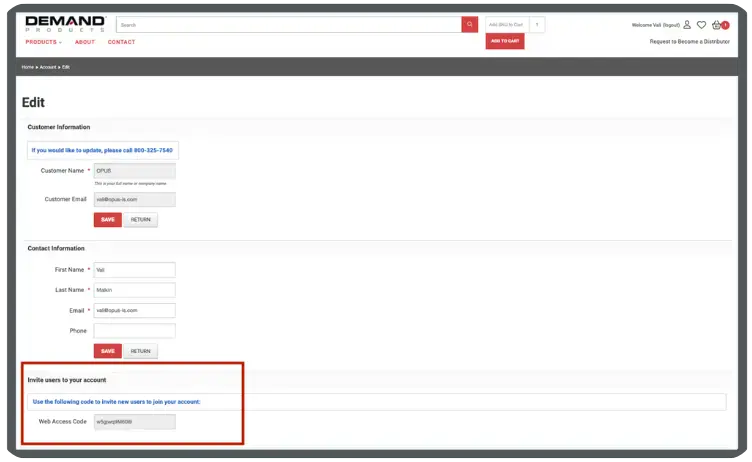5 Reasons Not To Use a B2C eCommerce Platform for Your B2B Business
Why BigCommerce and Other B2C Platforms Fall Short
10 minute read

Choosing the right eCommerce platform is crucial for B2B businesses. Why? Because eCommerce is an extremely fast growing sales channel.
- 66% of manufacturers expect to grow sales by 2% this year (2024) but they plan to grow their eCommerce sales 8 times faster than total sales.
- 21% of distributors reported that eCommerce sales accounted for 20–30% of their total revenues.
But eCommerce growth can have negative effects if, by using the wrong platform, operational efficiency plummets. While BigCommerce and other platforms initially designed for B2C markets offer attractive features, they often struggle to meet the unique demands of B2B transactions. In this article, we'll explore five reasons why using a B2C eCommerce platform, like BigCommerce, may not be suitable for your B2B operations. From managing complex user hierarchies to supporting complex pricing models and addressing specific inventory challenges, these platforms typically require extensive, time-consuming, and expensive customization to align with B2B requirements. These requirements include:
1. Support for Multiple Users Within the Same Customer
BigCommerce and many others with roots in B2C do not support a group of users under the same customer ID (i.e. within the same customer/company). Instead, individual user accounts are treated as separate entities and cannot be combined under one customer account.
This does not mean that users cannot have their own, unique logins. In most cases, they can. BUT what it does mean is that they cannot share needed company data from the same customer account.
This makes things difficult for B2B companies, where multiple employees or buyers (i.e users) from the same company need to share order history, prices, addresses, or invoices.
To support both companies (i.e. customers) and users (i.e. buyers) some type of cumbersome workaround is needed. One B2C eCommerce vendor suggests using the email domain as a pattern to identify, associate, and onboard users. For example, Joe Garcia from XYZ company with an email of "jgarcia@XYZ.com" would have to have his ERP customer number either changed to match that email address, or a custom procedure would have to be created to match him by his "@XYZ.com" domain; thereby, associating them with the same company. This can get messy very quickly.
However, this falls even further apart when dealing with contractors with non-standard email domains or users with common names. If you have two John Smiths (jsmith) or even a Joe Garcia and a Jose Garcia (jgarcia) at the same company, the database will lock up, and the ERP will fail.
Even a simple typo can cause everything to fail.
As users leave the company, each has to be removed in the ERP — not on the eCommerce platform. This is just another little piece of friction that allows tasks to fall between the cracks. This can be particularly challenging if you need to ensure former employees no longer have access to proprietary information.
All this leads to high service costs due to the extensive customizations required. In contrast, Nomad uses standard web services, eliminating the need for expensive custom GIs and making the platform more efficient and cost-effective.
Nomad does distinguish between users and customers. Users can self-register with web access codes—either generating them online or after receiving them via email. The code immediately associates them with the correct company, allowing them to see accurate pricing, orders, inventory levels, and any other piece of company data.

Additionally, user disengagement is straightforward, secure, and occurs directly from Nomad itself.
2. Business Rules Replication for Checkout and Payment Processes
Most eCommerce platforms with roots in B2C struggle to replicate complex business rules during the B2B checkout process.
This leaves many companies with only two choices.
- Build a custom stand-alone checkout that’s hosted separately.
- Forego replicating business rules during the checkout process altogether.
Many, however, find option #1 too complex and avoid it, resulting in no other choice except option #2.
And option #2 is not without significant problems. Without business rule automation, the checkout process (and the entire order-to-cash process) is significantly longer. Customers only receive estimated costs during checkout and have to wait for a follow-up email for the actual amount.
To generate these estimates, B2Bs often rely on general UPS libraries for quotes and less-preferred payment gateways for credit card pre-authorizations. Once the order is placed, they will need to contact the customer to provide the actual shipping costs and processing fees.
The checkout process also cannot be easily customized to capture crucial B2B details such as liftgate requirements, acceptance of Saturday deliveries, or the inclusion of customer-provided shipping accounts or PO numbers. This limitation means any expected efficiency benefits due to ERP integration and synchronization are completely negated.
Payment process customizations
Customizing the payment process in many popular eCommerce platforms presents challenges as well. Native support for ACH/e-check payment methods is often absent. Supporting a range of payment terms also requires customizations. For example, showing a customer's available credit limit, placing an order on credit hold if it exceeds the limit, or not displaying customer terms if they are on hold or over the limit all need custom development work. These limitations make managing a customer’s payment process cumbersome and inefficient.
83% of B2B buyers prefer placing orders or paying for goods through online channels.
Nomad integrates with any shipping or payment module and natively supports all custom business rules. If it is supported in your ERP, it is supported in Nomad.
3. Expansive Product Pricing Capabilities
Most B2C eCommerce platforms with roots in B2C, including BigCommerce, have limited customer pricing capabilities out-of-the-box. They can only display basic, individual item pricing. Complex pricing models like quantity-based pricing tiers, conversion factor pricing, location-based pricing (for those shipping from multiple warehouses), or order multiple requirements are not natively supported. Implementing such pricing rules would require extensive customization.
4. Complex Combinations of Inventory Units of Measure
Most B2C-oriented eCommerce platforms do not support selling inventory in different units of measure without creating separate item numbers. So for example, if you buy (let’s say) screws, you will probably buy them from a supplier in a crate. And each crate (for illustrative purposes) has 50 boxes of 200 individual screws.
ERP systems will let you sell those screws using different units of measure (e.g. crate, box, carton, etc.) without requiring unique item numbers for each unit. This flexibility means customers can purchase a single box of screws or a carton (equivalent to, for example, five boxes) from you, and these transactions are recorded as converted sales units against the crate, including converted pricing and inventory availability.
The problem occurs when the eCommerce platform that resides on top of the ERP cannot accommodate this functionality out-of-the-box.
To sell the same item across different units of measure many B2C platforms have to duplicate items as separate listings and sync them to the ERP with adjusting the pricing. This entire process is made harder if the eCommerce platform doesn't store prices beyond two decimal places. This limitation becomes problematic when pricing items like screws, where the cost per single box may include fractions of pennies that need to be rounded appropriately when scaling up to cartons.
Inability to Convert Units of Measure Between Stocking Units and Selling Units
Most B2C eCommerce solutions also struggle to perform unit of measure conversions between stocking units and selling units, which is critical for industries like manufacturing, flooring, and lumber where items are stocked in one unit (e.g. rolls) but sold in another (e.g. square feet).
Limited Inventory Display Capabilities
Most B2C eCommerce solutions have limited inventory display capabilities compared to the ERP. They cannot easily show inventory levels by warehouse location or control inventory visibility based on customer type or login status.
Nomad simplifies inventory complexities related to units of measure, component calculations, and visibility rules without extensive workarounds or custom coding. Unlike other vendors, Nomad eCommerce natively supports selling bulk inventory (e.g., crates) in smaller units (e.g., boxes), while dynamically adjusting pricing and inventory levels in real-time. B2C eCommerce platforms like BigCommerce lack this capability, requiring significant customization to achieve similar functionality.
5. Robust Product Configuration Capabilities
BigCommerce lacks a robust product configurator, instead using a “features and options bundler” approach that relies on listing every possible product configuration as a separate stocked item. This creates major scalability issues when item thresholds are hit.
For instance, the B2B company might only be able to assign up to 600 items per page, which can create challenges managing extensive product combinations for, say, a picnic table that can be built with 4 different types of frame finishes,, 4 different sizes, 12 different colors, 16 different metal coating options, and 20 different seating/table materials.
When companies exceed the 600-item limit, they face a choice: simplify their product offerings, sacrifice configuration capabilities, or fragment the different configurations across multiple pages. What could have been one comprehensive configuration page for all picnic table options is now split across dozens of pages, each tailored to sets of options such as material, coating, and number of seats. This restructuring alters the sales approach, potentially increasing the number of clicks customers need to configure their product and adding a large amount of friction to the sales process.
In contrast, Nomad's configurator leverages the bill of materials and components defined in the integrated ERP system. Instead of listing each configuration as an individual item, Nomad eCommerce dynamically generates a selection path from the virtually unlimited options and features stored in the ERP data. This allows for the presentation of a single, highly configurable product on the website that can adapt to thousands or even hundreds of thousands of potential configurations defined by the ERP rules. The result is a streamlined, easily maintained configurator experience.
As a Final Word....
While BigCommerce and other B2C platforms may offer quick fixes, they require heavy customizations to handle B2B complexities. A B2B-specific platform integrates seamlessly with your ERP, automates pricing, simplifies inventory, and supports advanced workflows like product configuration and multi-user management.
To see how a purpose-built B2B platform can streamline operations for HVAC and plumbing manufacturers and distributors, schedule a demo today.
Discover firsthand how Nomad can streamline your processes, enhance customer satisfaction, and drive growth.
Frequently Asked Questions
Why is using a B2C eCommerce platform for B2B business problematic?
B2C platforms often lack the necessary features to handle complex B2B requirements such as multi-user accounts, custom pricing, and seamless ERP integration, leading to costly customizations, workarounds, and general inefficiencies.
What are some B2B pricing issues that differentiate it from B2C pricing?
B2C platforms typically only support basic pricing. B2B businesses need complex pricing models like quantity-based discounts and location-based pricing, which B2C platforms can't handle without extensive modifications.
What are some challenges B2C platforms faced in terms of inventory management?
B2C platforms often can't support selling products in multiple units of measure or displaying inventory by warehouse location, causing inefficiencies and the need for complicated workarounds to support B2B processes.
.webp)